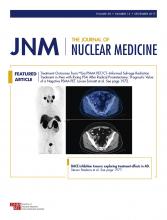TO THE EDITOR: In the case of prostate cancer, prostate-specific membrane antigen (PSMA) has been shown to be a valuable target for application by various ligands in clinical diagnosis. The unique feature of PSMA is the pocket, 70 Å long, with 2 binding sites in the tip addressed by the chiral centers of S-amino acids such as those used by Kularatne et al. (1). In the middle, additional binding sites are highly selective for centers with high electron densities such as π-electrons. Various developments were performed such as those by Low, Pomper, and their colleagues (1–3). An important contribution was brought up by the work of Sterzing et al., who developed and proved the use of 68Ga-PSMA-11 (68Ga-PSMA-HBED-CC) for diagnosis of prostate cancer by PET imaging directly in patients (4). Meanwhile, there are various compounds labeled with 68Ga and 18F, and indeed, there now is a discussion on which radionuclide to prefer for labeling, as featured in a “Hot Topics” article of The Journal of Nuclear Medicine by Kesch et al. (5). Many PSMA ligands are labeled by 68Ga in a complex attached to the molecule of interest. That approach exhibits the outstanding advantage of applying the same compound in therapy just by choosing the appropriate radionuclide, such as 90Y or 177Lu. That, however, is not possible in the case of 18F-compounds in which the radionuclide is bound via a prosthetic group.
It is the aim of our letter to draw attention to a highly interesting alternative developed by McBride et al. (6). They showed the easy formation of Al18F2+ and application for labeling by complex formation, as has been well applied in the case of 68Ga. The surprising observation was that Al18F2+ exhibits the chemical behavior of a radiometal and that the labeling process was through complex formation using a kit procedure as performed by Malik et al. (7) and Boschi et al. (8) and schematically described by us recently (9).
When compared with 68Ga, 18F exhibits quite a few advantages. The longer half-life (110 min vs. 68 min) allows single-batch preparation for many patients, even in 1 day. Moreover, late and longer registrations are possible, thus increasing contrast and the detection of small lesions due to the low positron energy of 18F (0.65 MeV, vs. 1.9 MeV for 68Ga) (10).
68Ga is available as a generator radionuclide, and the fact that 18F has to be produced by a cyclotron is usually thought to be a disadvantage. However, during the past 10 years, the number of cyclotrons has greatly increased, finally reaching a kind of “all around” availability. After any 18F production run, just a flushing of the target systems supplies waste 18F activity in a high amount, so that practically no production costs exist.
In summary, the facile and high-yielding radiosynthesis of PSMA ligands that is possible using Al18F2+ chemistry makes it worthy for clinical development in PET imaging of prostate cancer, compared with the clinically established 68Ga-PSMA tracers.
Footnotes
Published online Jun. 29, 2017.
- © 2017 by the Society of Nuclear Medicine and Molecular Imaging.







